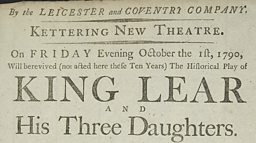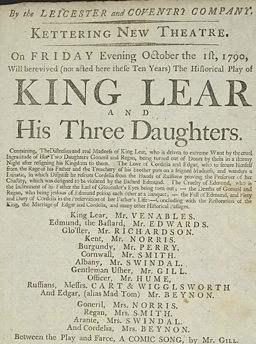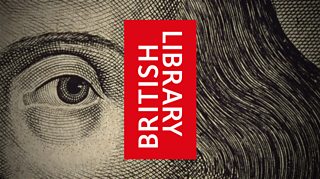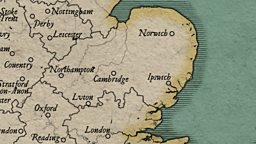King Lear with a happy ending in Kettering
Shakespeare's works were far from sacrosanct. Here’s a popular adaptation of King Lear where almost everyone, except for the real 'baddies', lives happily ever after. Loved by spectators, loathed by many critics, Lear with a happy ending grew in popularity and was performed across England for over 150 years.
King Lear, Shakespeare’s epic tragedy, is playing in Kettering on 1 October 1790. But there’s something strange about it.
-
![]()
Much ado near me
Hear more Shakespeare stories on BBC Radio Northampton
-
![]()
Shakespeare Festival 2016
The BBC celebrates the genius of the bard

In this version the ending has been 'adapted' - the King restored to his throne, and Edgar and Cordelia married.
You could almost hear someone add the timely phrase, ”and everyone lived happily ever after” at the end of this particular version. So what’s going on here?
The historical play of King Lear and his Three Daughters is an adaptation by the writer and poet Nahum Tate (1652-1715), which first appeared in 1681. It is thought to have replaced Shakespeare’s original version until about 1838.
Tate found the ending of the play too sad and others agreed, so he changed it into a tragi-comedy - adding a dash of romance, cutting the text and the role of the Fool, adding his own words, and lowering the body count.
In his version both King Lear and his daughter Cordelia live, the King grants his daughter the throne, which she will rule with Edgar, who is soon to become her husband.
Edgar sums up the mood of this version in his closing speech:
Our drooping Country now erects her Head,
Peace spreads her balmy Wings, and Plenty Blooms.
Divine Cordelia, all the Gods can witness
How much thy Love to Empire I prefer!
Thy bright Example shall convince the World
(Whatever Storms of Fortune are decreed)
That Truth and Vertue shall at last succeed.
Why change King Lear?
It’s thought that there were a number of other reasons why Tate may have adapted Lear. There may have been sensitivities about a plot which centred on the fall of the ageing King Lear, at a point in England’s history when a King had just been reinstated. Restoration audiences included a well-to-do elite whose tastes were a little more prudish than their predecessors.
Although many critics derided the adaptation for its sentimentality, audiences loved it and the leading actors of the time, Thomas Betterton, David Garrick and John Philip Kemble, all famous for their portrayals of Lear, used Tate’s version.
In 1820, a few years before the death of King George III, it was felt that the situation of Shakespeare's mad monarch may have been a shade too similar to that of the ageing King of Britain.
However, over the following years there were attempts to get closer to Shakespeare’s original play. Actor Edmund Kean reinstated the original tragic ending of King Lear, but although his acting earned praise, these performances did not go down well and he reverted to Tate’s version of the play.
In 1834 another well-known actor, William Charles Macready, championed a 'restored' version of Shakespeare’s play - a version of the tragedy that included the original ending. Audiences responded positively and the success of this production paved the way for the eventual reintroduction of the complete, original text in 1845 by the actor-manager Samuel Phelps.


About Shakespeare on Tour
From the moment they were written through to the present day, Shakespeare’s plays have continued to enthral and inspire audiences. They’ve been performed in venues big and small – including inns, private houses and emerging provincial theatres.

BBC English Regions is building a digital picture which tracks some of the many iconic moments across the country as we follow the ‘explosion’ in the performance of The Bard’s plays, from his own lifetime to recent times.
Drawing on fascinating new research from Records of Early English Drama (REED), plus the British Library's extensive collection of playbills, as well as expertise from De Montfort University and the Arts and Humanities Research Council, Shakespeare on Tour is a unique timeline of iconic moments of those performances, starting with his own troupe of actors, to highlights from more recent times. Listen out for stories on Shakespeare’s legacy on your BBC Local Radio station from Monday 21 March, 2016.
You never know - you might find evidence of Shakespeare’s footsteps close to home…
Craig Henderson, BBC English Regions
-
![]()
Shakespeare Lives
The nation’s greatest performing arts institutions mark 400 years since the Bard's death

Shakespeare on Tour: Around Northampton
-
![]()
Iconic Magna Carta Performance of King John
Marking the 800 year anniversary of the Magna Carta
-
![]()
The Northampton Repertory Theatre
Pieces of history in Northampton
-
![]()
Shakespeare teased Daventry…and the comedy carries on
Tired travellers treated to The Taming of the Shrew
-
![]()
Modern day Macbeth for Corby steel town
The adaptation encouraged younger viewers to connect to Shakespeare
Shakespeare on Tour: Around the country
-
![]()
Lancaster Theatre sparkles with Shakespearean talent
The Grand Theatre in Lancaster, which was once managed by Stephen Kemble
-
![]()
Reading’s Puritans turn away Shakespeare
Shakespeare's men paid not to play in Reading
-
![]()
Belvoir Castle
Belvoir Castle, home of the Duke of Rutland
-
![]()
Did Shakespeare visit Bristol in 1597?
Civic accounts show a high amount of performances in Bath











